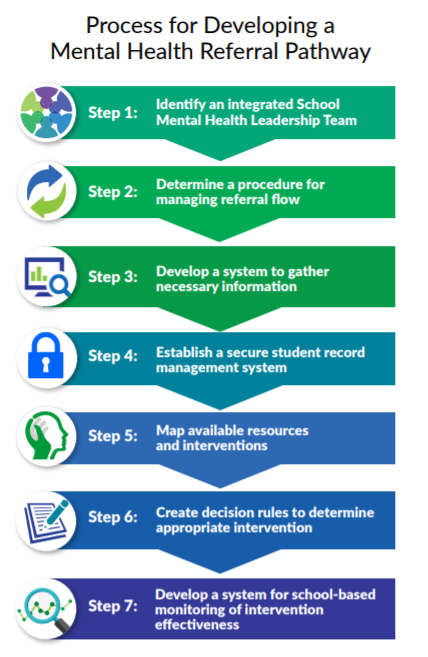Introduction
School mental health referral pathways are the processes and procedures used to identify student mental health needs and connect students with the appropriate mental health supports and resources. These pathways exist in the context of an equitable, multi-level system of supports, which provides a conceptual model for organizing mental health supports in schools. Clearly defined referral pathways are an essential part of meeting the needs of every learner because they:
- Provide next steps for staff when they identify a student in need;
- Coordinate supports within schools and between schools and outside organizations
- Improve student outcomes through early identification and intervention
Although the word “referral” can mean connecting a student to external service providers, a highly functional referral pathway includes pathways to both school and community supports, with strong relationships and sustained collaboration between both systems.
Referral Pathway Action Steps
In order to create an effective pathway, schools must consider the specific needs and resources of their school and community. Schools can utilize the Referral Pathways Self-Assessment to assess the current functioning of referral procedures. After identifying gaps in the pathways, schools can utilize the following action steps to address gaps in the system.

School Mental Health Referral Pathways Module Series
![]() View the School Mental Health Referral Pathways Module Series for more information, tools, and local examples. This module series can be utilized by schools that are at any point in the process of building and improving their mental health referral pathways.
View the School Mental Health Referral Pathways Module Series for more information, tools, and local examples. This module series can be utilized by schools that are at any point in the process of building and improving their mental health referral pathways.
- Module 1: Building School Mental Health Referral Pathways
- Module 2: Improving School Mental Health Referral Pathways
- Module 3: School Mental Health Referral Pathways in Action
Building or strengthening existing pathways to mental health support: Refer to DPI’s Mental Health Referral Pathways document
Comprehensive look at school mental health referral pathways: Refer to SAMHSA’s School Mental Health Referral Pathways Toolkit
Tools and Resources
For more tools and resources, use the dropdown menus below to explore each step in building a school mental health referral pathway.